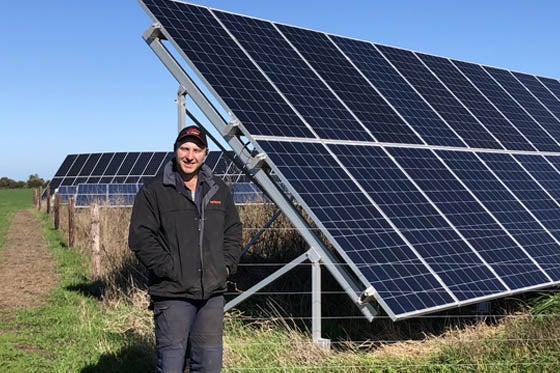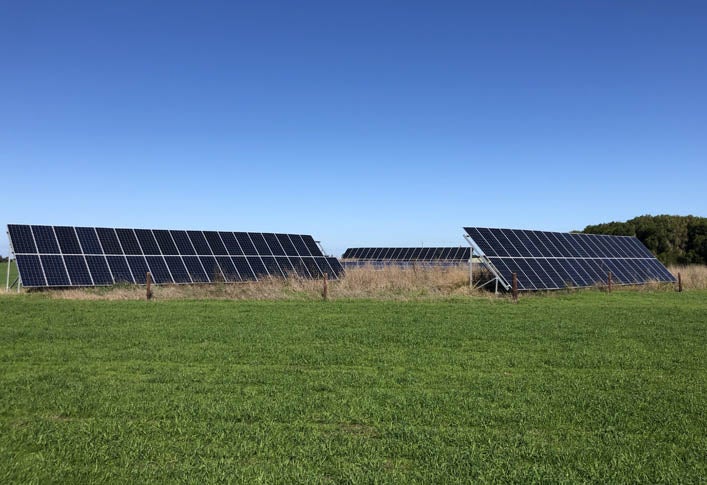Posted by on
24/05/2021
For South Australia’s Telford family, milking 2,800 cows across three dairies can be a costly business considering the startling rise in electricity prices.
With their power bills becoming an increasingly significant spend, Justin Telford, who runs ‘Mundoolun Dairying’ in the Schank district in conjunction with his brother Travis and parents Trevor and Lynn, began researching options to help keep input costs down – with solar emerging as the most cost-effective solution.
With few solar examples within the district, Justin relied on online research and talking to dairy farmers from other regions, but with a healthy interest in renewables and ‘saving a dollar’ he was confident solar was the way forward.
“We spent about four months crunching the numbers, and looked into using wind energy, which didn’t prove viable. We were also wary of the door-to-door type salespeople trying to flog solar options, so we took the time to find the right company that aligned with our business and personality,” Justin said.
In the end, the right company – CommPowerIndustrial – came to them, after hearing of the Telford’s intentions through the dairy industry network.
With a proven track record in some of the largest roof panelling solar installations in Australia, Justin said he was impressed with CommPowerIndustrial from the outset, with the company offering a whole service – sourcing inputs, installation and follow-up support.
The team even customised the Telford’s system to ensure it utilised the most efficient and effective panel design and direction.
The Telford’s installed their first system, on Dairy One, in 2018 – a 100KW roof panel system intended to pay itself off in 26 months.
After just 12 months Justin said their savings were reviewed, to find they were only $1,500 off their projected target – with the system having now well and truly paid for itself, 30 months later.
The family followed up with a second similar system on Dairy Three 18 months later, which has also now almost paid itself off.

The process itself, he said, was streamlined – a few weeks negotiating a proposal and costings, followed by a two week physical build, consisting of two to three builders.
“In total the turn-around was about six weeks all up, and the company was excellent to deal with – there were no hold ups, and they worked around our needs so we could continue milking throughout the process.”
The most recent infrastructure on the property – which also runs beef cattle and pastures – is a 480KW system installed to run a five centre irrigation pivot, purchased through a power purchase agreement with a third party.
This, Justin said, had been less straight-forward, and he’s currently working with a third party electricity retailer to upgrade circuiting in order to meet industry requirements.
“We haven’t been able to run the pivot yet due to the network hold up, but we’re expecting the cost benefit should be just as impressive.”
Dairy Two is pegged for a new system in the next eight to 12 months, with Justin’s biggest regret being that he didn’t do his three dairies at once, initially.
“Our electricity spend was about $600,000 – which is out of control,” he said. “Now with the two systems alone we save about $100,000 a year.”
“The cost benefit is enormous, and with the current tax benefits, there’s no better time to invest. In this day and age, whether you’re in agriculture, manufacturing or even just residential – if you don’t have solar you’re a step behind the game.”
Grateful to his progressive-minded parents for encouraging investing in renewables, Justin admitted their operation certainly felt like the exception, rather than the norm, within their region.
But Justin has little doubt renewables are the way forward when it comes to facilitating genuine on-farm savings.
Currently piquing his interest for future investment, a storage device – a super capacitator with a 30 year life cycle that remains fully charged.
Hydrogen engines to replace the current diesel systems on his centre pivot are also options he’s keen to explore later down the track.
“There are some really exciting options out there, and if we can save $100,000 a year from our recent upgrades, then that’s better in our pocket than the power company’s,” Justin smiles.
